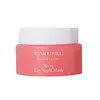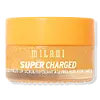What's inside
What's inside
 Key Ingredients
Key Ingredients

 Benefits
Benefits

 Concerns
Concerns

 Ingredients Side-by-side
Ingredients Side-by-side

Polyisobutene
Paraffinum Liquidum
EmollientPetrolatum
EmollientDiisostearyl Malate
EmollientBeeswax
Emulsion StabilisingEuphorbia Cerifera Wax
Hydrogenated Styrene/Isoprene Copolymer
Ceresin
Emulsion StabilisingSorbitan Sesquioleate
EmulsifyingCaprylyl Glycol
EmollientParfum
MaskingTitanium Dioxide
Cosmetic ColorantPolyglyceryl-2 Triisostearate
EmulsifyingSynthetic Fluorphlogopite
1,2-Hexanediol
Skin ConditioningTocopheryl Acetate
AntioxidantCI 19140
Cosmetic ColorantCI 15850
Cosmetic ColorantTin Oxide
AbrasiveWater
Skin ConditioningOlea Europaea Fruit Oil
MaskingButylene Glycol
HumectantMacadamia Integrifolia Seed Oil
Skin ConditioningTocopherol
AntioxidantLavandula Angustifolia Flower Extract
CleansingRosa Canina Flower Extract
AstringentChamomilla Recutita Flower Extract
MaskingPaeonia Officinalis Flower Extract
TonicRosa Centifolia Flower Extract
AstringentCamellia Japonica Flower Extract
EmollientLilium Tigrinum Extract
Skin ConditioningRubus Idaeus Fruit Extract
AstringentFragaria Chiloensis Fruit Extract
Skin ConditioningPunica Granatum Fruit Extract
AntioxidantTricholoma Matsutake Extract
Skin ConditioningNelumbo Nucifera Flower Extract
Skin ConditioningSchisandra Chinensis Fruit Extract
Skin ConditioningPanax Ginseng Root Extract
EmollientMoringa Oleifera Seed Extract
Skin ConditioningPolyisobutene, Paraffinum Liquidum, Petrolatum, Diisostearyl Malate, Beeswax, Euphorbia Cerifera Wax, Hydrogenated Styrene/Isoprene Copolymer, Ceresin, Sorbitan Sesquioleate, Caprylyl Glycol, Parfum, Titanium Dioxide, Polyglyceryl-2 Triisostearate, Synthetic Fluorphlogopite, 1,2-Hexanediol, Tocopheryl Acetate, CI 19140, CI 15850, Tin Oxide, Water, Olea Europaea Fruit Oil, Butylene Glycol, Macadamia Integrifolia Seed Oil, Tocopherol, Lavandula Angustifolia Flower Extract, Rosa Canina Flower Extract, Chamomilla Recutita Flower Extract, Paeonia Officinalis Flower Extract, Rosa Centifolia Flower Extract, Camellia Japonica Flower Extract, Lilium Tigrinum Extract, Rubus Idaeus Fruit Extract, Fragaria Chiloensis Fruit Extract, Punica Granatum Fruit Extract, Tricholoma Matsutake Extract, Nelumbo Nucifera Flower Extract, Schisandra Chinensis Fruit Extract, Panax Ginseng Root Extract, Moringa Oleifera Seed Extract
Sucrose
HumectantHelianthus Annuus Seed Oil
EmollientRicinus Communis Seed Oil
MaskingPolybutene
Helianthus Annuus Seed Wax
Skin ConditioningSilica
AbrasiveDiisostearyl Malate
EmollientArgania Spinosa Kernel Oil
EmollientCocos Nucifera Oil
MaskingRosa Canina Fruit Oil
EmollientSiraitia Grosvenorii Fruit Extract
Skin ConditioningPrunus Amygdalus Dulcis Oil
Skin ConditioningCurcuma Longa Root Extract
MaskingPanax Ginseng Root Extract
EmollientCitrus Reticulata Fruit Extract
Skin ProtectingSynthetic Wax
AbrasiveIsopropyl Titanium Triisostearate
EmollientPhenoxyethanol
PreservativeAroma
Benzyl Benzoate
AntimicrobialCitral
PerfumingLimonene
PerfumingLinalool
PerfumingCinnamal
PerfumingIron Oxides
CI 19140
Cosmetic ColorantSucrose, Helianthus Annuus Seed Oil, Ricinus Communis Seed Oil, Polybutene, Helianthus Annuus Seed Wax, Silica, Diisostearyl Malate, Argania Spinosa Kernel Oil, Cocos Nucifera Oil, Rosa Canina Fruit Oil, Siraitia Grosvenorii Fruit Extract, Prunus Amygdalus Dulcis Oil, Curcuma Longa Root Extract, Panax Ginseng Root Extract, Citrus Reticulata Fruit Extract, Synthetic Wax, Isopropyl Titanium Triisostearate, Phenoxyethanol, Aroma, Benzyl Benzoate, Citral, Limonene, Linalool, Cinnamal, Iron Oxides, CI 19140
 Reviews
Reviews

Ingredients Explained
These ingredients are found in both products.
Ingredients higher up in an ingredient list are typically present in a larger amount.
CI 19140 is also known as Tartrazine. Tartrazine is a synthetic dye used in cosmetics, foods, and medicine to add a yellow color.
Tartrazine is created from petroleum and is water-soluble.
Some people may experience allergies from this dye, especially asthmatics and those with an aspirin intolerance.
Learn more about CI 19140Diisostearyl Malate is an emollient and most often used in lip products. It comes from isostearyl alcohol, a fatty acid, and malic acid, an AHA.
As an emollient, Diisostearyl Malate helps create a thin film on your skin to trap moisture in. This helps keep your skin soft and smooth.
Ginseng root is a well-loved ingredient in Asian skincare for good reason. It hydrates the skin, soothes irritation, and helps even out skin tone.
In traditional East Asian medicine, ginseng has been used for centuries both as food and as a healing remedy, and modern research continues to confirm its skin benefits.
One of the standout features of ginseng is its ability to improve blood circulation and oxygen delivery to the skin, bringing a fresh supply of nutrients to support overall skin health. It also has antioxidant and anti-inflammatory properties. This helps to protect your skin against damage from UV exposure, pollution, and daily stress.
Additionally, studies suggest that ginseng may help reduce hyperpigmentation by inhibiting tyrosinase, the enzyme involved in melanin production.
There are different types of ginseng used in skincare, and while they all share core benefits, their potency can vary.
Most products use fresh or white ginseng because it’s more affordable. However, red ginseng, produced by steaming the root, contains higher levels of ginsenosides, which are compounds with proven anti-aging effects. These ginsenosides help reduce the appearance of wrinkles and improve skin elasticity.
Note: All forms of ginseng are listed simply as “Panax ginseng” in ingredient lists. We recommend reaching out to the brand if you have questions about which type of ginseng is used in their ingredients.
For general antioxidant benefits, any ginseng extract will do, but for wrinkle care or firmer skin, red or fermented ginseng is often more effective.
In short, ginseng is a powerhouse ingredient that supports hydration, radiance, and resilience.
Learn more about Panax Ginseng Root Extract